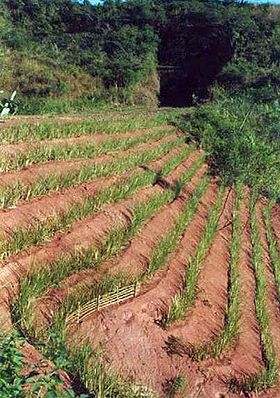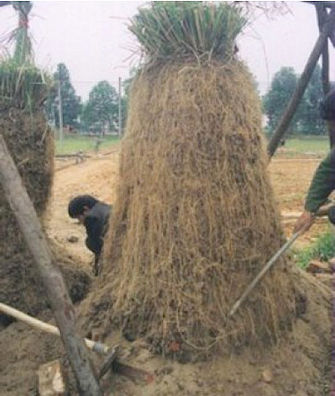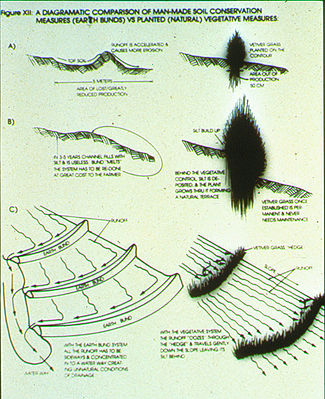How to Fight Soil Erosion by planting Vetiver Grass
Contents
Short Description
- Problem: Soil erosion, gullies, nutrients loss, road-side & river bank erosion, river and lake pollution, groundwater depletion.
- Idea:Planting continuous hedges of Vetiver on the contour lines or along rivers and roads. the leaves of vetiver filter the runoff while the deep roots retain the soil and help water infiltration.
- Difficulty: Implementation is labour intensive.
- Maintainance:Low
- Price Range:
- Material Needeed: A-level for contour lines, Vetiver, showels and labour
- Geographic Area:Tropical to semi-arid areas, needs sun.
- Competencies: Contour lines definition.
- How Many people?
- How Long does it take? After 6 month, the hedge is usually already fully effective. Terraces usually form after 3 to 4 years.
Common Names
Common Names for Vetivert Grass:
China: Xiang-Geng-chao;
Amharic: Yesero mekelakeya;
Dagomba: Kulikarili;
Hindi: Bala, Balah, Bena, Ganrar, Khas,Onei, Panni;
Urdu: Khas;
Bengali: Khas-Khas;
Gujarati: Valo;
Marathi: Vala Khas-Khas;
Mundari: Birnijono, Sirum, Sirumjon;
Oudh: Tin;
Punjabi: Panni;
Sadani: Birni;
Santali: Sirom;
Telugu: Avurugaddiveru, Kuruveeru,Lamajjakamuveru, Vettiveeru,Vidavaliveru;
Tamil: Ilamichamver, Vettiver, Vilhalver,Viranam;
Kannada: Vettiveeru, Laamanche, Kaadu,Karidappasajje hallu;
Malayalam: Ramaccham, Ramachehamver, Vettiveru;
Indonesia: Aga wangi, Larasetu, Larawestu, Raraweatu;
Sundanese: Janur, Narawastu, Usar;
Persian: Bikhiwala, Khas;
Malaysia: Nara wastu, Nara setu, Naga setu,Akar wangi (fragrant root),Rumput wangi (fragrant grass),Kusu-kusu;
Hausa: Jema;
Fulani: So'dornde, So'mayo, Chor'dor'de,Ngongonari, Zemako;
Philippines: Ilib, Mora, Moras, Moro, Muda, Narawasta, Raiz de moras, Rimodas, Rimora, Rimoras,
Tres-moras, Vetiver, Amoora, Amoras, Anias de moras, Giron
Sahel;
Bambara: Babin, Ngongon, Ngoko ba;
Songhai: Diri;
Fulani: Kieli, Dimi, Pallol;
Sarakolle: Kamare;
Mossi: Roudoum;
Gurma: Kulkadere;
Senegal
Wolof: Sep, Tiep;
Fulani: Toul;
Tukulor: Semban;
Sierra Leone
Mende: Pindi;
Susu: Barewali;
Temne: An-wunga ro-gban;
Sri Lanka Sinhalese: Saivandera, Savandramul;
Thailand: Faeg;
The Vetiver System
The Vetiver System (VS) is dependent on the use of a very unique tropical plant, Vetiver grass – Vetiveria zizanioiodes. The plant can be grown over a very wide range of climatic and soil conditions, and if planted correctly can be used virtually anywhere under tropical, semi-tropical, and Mediterranean climates. It has characteristics that in totality are unique to a single species. When vetiver grass is grown in the form of a narrow self-sustaining hedgerow it exhibits special characteristics that are essential to the many different applications that comprise the Vetiver System.
The species of Vetiveria zizanioides, that is promoted in nearly 100 countries for VS applications originates in south India, is sterile, non invasive and has to be propagated by clump subdivision. Generally nursery multiplication of bare rooted plants is the preferred method. The average multiplication rate varies but is normally about 1:30.
After about three months nursery clumps are divided into planting slips of about 3 tillers each. These are then planted 15 cm apart on the contour to create, when mature, a barrier of stiff grass that acts as a buffer and spreader of down slope water flow, and a filter to sediment. A good hedge will reduce rainfall run off by as much as 70% and sediment by as much as 90%. A hedgerow will stay where it is planted and the sediment that is spread out behind the hedgerow gradually accumulates to form a long lasting terrace with vetiver protection. It is a very low cost, labor intensive technology (linked to the cost of labor) with very high benefit: cost ratios. When used for civil works protection its cost is about 1/20 of traditional engineered systems and designs.
Vetiver grass can be used directly as a farm income product, or it can be used as an application that will protect river basins and watersheds against environmental damage particularly point source environmental problems relating to: (1) sediment flows (2) excess nutrients, heavy metals and pesticides in leachates from toxic sources. The two major uses are closely linked. Below are the main categories of application. You can find Power Point type presentations for each category at: http://picasaweb.google.com/VetiverClients. All these applications can directly or indirectly impact on the rural poor through either protection of farm land and, where necessary its rehabilitation, provision of direct farm income, or indirectly improving the quality of life and resources available to the poor.
There are three questions that are always asked by agriculturists:
- Does vetiver make a good fodder? The answer, supported by research, is yes, if cut and managed correctly. It also makes a good maintenance ration in the dry season when most other forage plants have either died or become unpalatable;
- Does it cause erosion problems when dug up for its roots? In our experience over the past 20 years this has never been a problem when farmers are properly trained in its use. There have been cases in Haiti where erosion is associated with the harvesting of vetiver roots for oil. On careful investigation it was found that in most cases vetiver had been planted on already eroding and denuded land unfit for other agricultural purposes, and that little care or management was associated with the harvesting;
- Is vetiver grass invasive? The seeds (if produced at all) of the south Indian cultivar of Vetiveria zizanioides are sterile and its roots are not stoloniferous. Thus vetiver hedgerows remain where planted and do not compete with native species in fact to the contrary vetiver hedgerows improve the microclimate and in consequence help native species to grow and thrive.
Vetiver Systems can be used by most of the sectors involved in rural and community development. It should not just be left solely to the agricultural sector to promote, but should be incorporated, where appropriate, into the development plans for community, district or region. If all the sectors use it, there is then an opportunity for vetiver grass producers, both small and big to get involved with VS as an income generating enterprise, whether it be producing planting material, contracting as landscapers for slope stabilization and other needs, or selling vetiver byproducts such as handicrafts, mulch, thatch, forage and other material. Over and above this, of course is its use in on farm soil and water conservation, and the benefits that are derived from that application.
It is a technology common to so many different applications that if widely applied might be the kick-start to a significant climb out of poverty for a large segment of the community.
Vetiver System – An Overview
- The Plant
- Propagation and Planting
- Poverty Alleviation
Agricultural applications:
- Soil and Water Conservation
- On Farm Use and Products
Water and Water Quality applications:
- Flood Control<br
- River Banks
- Dams, Ponds and Lakes
- Mine and Quarry Rehabilitation
- Pollution Control
- Landfill
Slope Stabilization applications:
- Rural Roads
- Highways - batter/ fill and drainage
- Railroads
- Land Rehabilitation
- Pipeline and electricity utilities
Urban Landscaping
Other uses:
- handicrafts,
- aromatic oils,
- medicinal etc.
Success Story
Vetiver was introduced successfully for erosion control in the Fiji Islands by John Greenfield. These contour hedges have proved efficient over the past 60 years. Natural terraces of up to 3 m formed along vetiver hedges within 25 years. The problem Fiji faces today is the destroying of thoses hedges by people ignorant of the specific role of vetiver.
Plans, Illustrations, Posters
Difficulties
Contacts
Vetiver System and Its Applications: for details go tp: http://picasaweb.google.com/VetiverClients and http://www.vetiver.org
Vetiver Grass Application Guide at eBay: http://reviews.ebay.com/Vetiver-Grass-Application-Guide_W0QQugidZ10000000005875095
Vetiver Grass Users Group at Facebook: http://www.facebook.com/group.php?gid=9168832759
Vetiver System Google Group: http://groups.google.com/group/vetiver-system?hl=en
Links
Texts that support various Vetiver applications can be found under the following headings on the Vetiver Network (International) Website: www.vetiver.org
Link to Fourthway's poster "How to stop soil erosion": http://www.fourthway.co.uk/posters/pages/soilerosion.html
Link to Fourthway's poster "Why Mulch?": http://www.fourthway.co.uk/posters/pages/mulch.html
Bibliography
Report on the potential weed problem of vetiver grass and its effectiveness in soil erosion control in fiji, Paul Truong & Colin Creighton
Related articles
- How to Fight Soil Erosion by planting Vetiver Grass
- How to FightSoil Erosion
- How to Stop Gullies on Eroded Slopes
- How to Build Causeways out of Dry Stone
- How to Harvest Rainwater
- How to Harvest Run Off Rainwater
- How to Process Nutmeg and Mace
- What to Do with Neem Seeds
- Ecological Sanitation
- How to Start Culture in Zai Holes
- How to Control Water Hyacinth
- How to Recycle Rubber
Categories
- Stub
- Agriculture
- Communication
- Community
- Construction
- Crisis Management
- Forest
- Ideas
- Pollution
- Prevention
- Resource Management
- Soil
- Run-Off
- Water
- Water harvesting
- Irrigation
- Wind
- Biodiversity
- Medium
- Global Technology
- Arid Climate
- Forest Environment
- Global
- Mediterranean Climate
- Monsoon Climate
- Rainy season
- Montaneous Environment
- Coastal Area
- Lakes and Rivers
- Rural Environment
- Temperate Climate
- Tropical Climate
- Urban Environment
- Clay
- Compost
- Seeds
- Seedlings
- Straw
- Tea
- Tyres
- Vetiver
- Wood
- One Person and more
- Household
- Village
- Neighbourhood
- Application
- Principles
- Howtopedia requested drawings
- Howtopedia requested images
- Requested translation to Spanish


